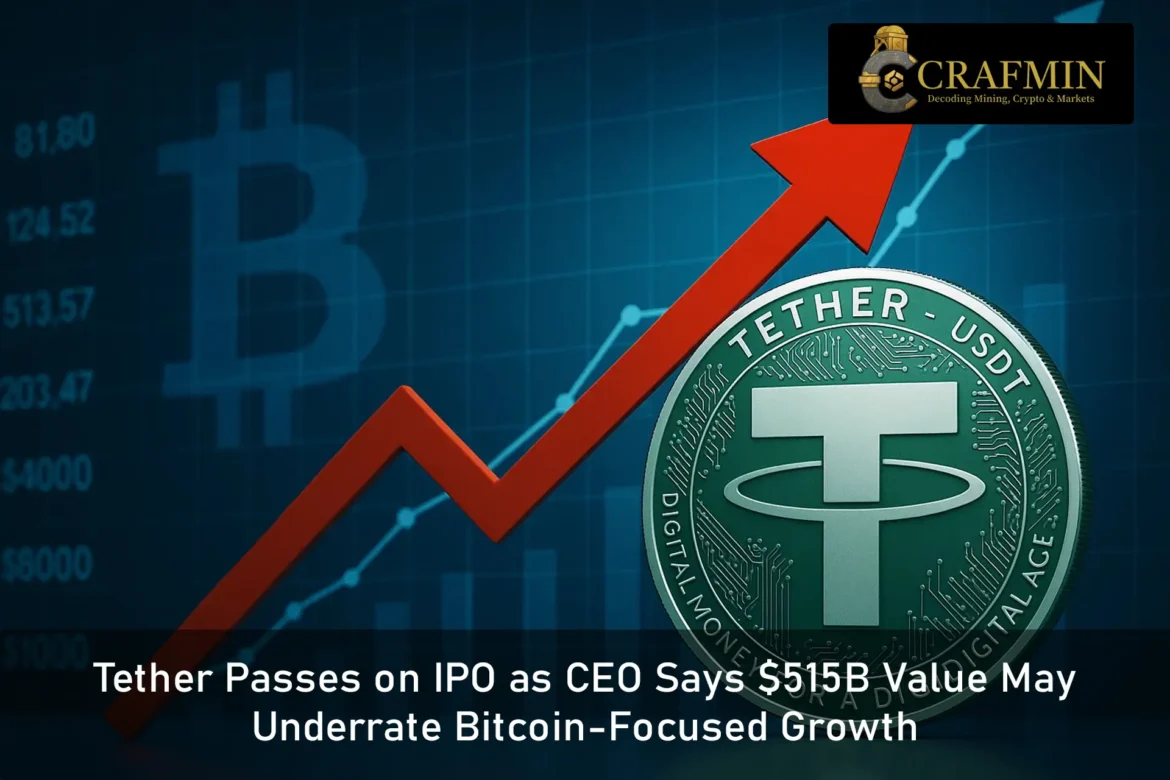Tether Rejects Public Listing as CEO Calls $515 Billion Valuation Conservative
Tether, the company behind the world’s largest stablecoin, USDT, has no plans to enter the share market despite renewed attention on crypto firms following Circle’s recent public listing.
Just days after Circle, the issuer of USDC, began trading on the New York Stock Exchange, Tether’s Chief Executive Paolo Ardoino confirmed that the company is not considering the same path. While Circle enjoyed a significant market boost during its debut, Ardoino stated that Tether is already on a strong growth trajectory and does not require public investment to fuel expansion.
The USDT stablecoin plays a central role in the global cryptocurrency ecosystem, offering a token designed to maintain a stable value, typically pegged to the US dollar. Tether has long held the top position in this space, and the company’s profits and asset base continue to grow substantially.

Image 1: Paolo Ardoino, the Chief Executive Officer of Tether (Source: Camilo Freedman—Bloomberg/Getty Images)
Analyst Suggests Tether’s Value Rivals Major Global Firms
While Tether has chosen to remain private, industry analysts are still trying to assess its potential market worth. John Ma, a respected cryptocurrency and financial markets analyst, recently estimated that if Tether were to go public today, it could reach a market valuation of approximately $515 billion.
According to Ma’s breakdown, the figure places Tether ahead of household names like Costco and Coca-Cola on the global company value list. He drew the comparison using financial metrics based on Circle’s current public valuation. Circle is currently valued at around $30 billion and is trading at a high multiple of its earnings—about 69 times its projected earnings before interest, taxes, depreciation, and amortisation (EBITDA).
Using that same multiple, Ma applied it to Tether’s financial performance. Tether reported net profits of around $13 billion in 2024, with roughly $7 billion of that total derived from returns on government bonds and repurchase agreements. An additional $5 billion was linked to gains in its holdings of Bitcoin and gold. However, since those were unrealised gains—meaning the assets weren’t sold—they were not included in the operating profit calculation.
For 2025, Ma projected that Tether’s issuance of USDT could grow by another $50 to $60 billion, bringing the average supply to about $170 billion for the year. Assuming interest rates remain around 4.2%, Ma estimates this growth could generate $7.4 billion in EBITDA. When that figure is multiplied by the 69.3 valuation metric used for Circle, it leads to the $515 billion result.
Tether valuation at 515B is a beautiful number.
Maybe a bit bearish considering our current (and increasing) Bitcoin + Gold treasury, yet I’m very humbled.
Also truly excited for the next phase of growth of our company.Thank you everyone❤️ https://t.co/exZc05SDwd
— Paolo Ardoino (@paoloardoino) June 7, 2025
Company Focuses on Treasury Growth Over Market Hype
Rather than expressing surprise at the estimate, Ardoino responded by suggesting that the figure might actually undervalue the company, given the strength and growth of its Bitcoin and gold reserves. He noted that Tether’s current holdings in those assets continue to expand and represent a significant portion of the company’s strategy moving forward.
Tether has recently made strategic moves to deepen its position in the cryptocurrency treasury space. On 24 April, it was announced that Tether had become the majority stakeholder in Twenty One Capital, a Bitcoin-focused investment firm founded by Strike CEO Jack Mallers. This acquisition highlights Tether’s broader ambitions to play a key role in digital asset finance beyond just stablecoins.
Although Twenty One Capital has only recently launched, it already holds a substantial amount of Bitcoin, placing it among the top corporate investors in the asset. Based on available data, its Bitcoin holdings rank just below those of Strategy (formerly MicroStrategy) and MARA Holdings, a major mining company. This quick climb in ranking reflects the scale of Tether’s involvement and the strategic importance it places on Bitcoin reserves.
Adding to that momentum, Tether transferred over 37,000 Bitcoin—worth nearly $4 billion—on 3 June to addresses associated with the new investment platform. This substantial move demonstrates both the scale of Tether’s crypto assets and its commitment to integrating those holdings into its long-term strategy.

Image 2: (Source: la Repubblica)
No Appetite for Listing as Private Structure Supports Growth
Even with growing interest in crypto companies going public, Tether remains firm in its decision to avoid the stock exchange. When asked about the potential advantages of a public listing, Ardoino responded that the company sees no benefit in doing so at this stage.
The position reflects Tether’s confidence in its current model. It continues to operate profitably without relying on external investment or the obligations of public company status. The company maintains full control over its strategy, avoids the reporting demands of shareholders, and has the flexibility to act swiftly in the rapidly evolving crypto market.
Read Also: Circle’s IPO Ushers in a New Era for Crypto’s Public Market Presence
With rising earnings, expanding stablecoin supply, and increasing exposure to valuable digital assets like Bitcoin and gold, Tether appears well-positioned to continue its trajectory privately. The business has established itself as a central figure in crypto finance, and its internal strength and vision suggest that public status is not a requirement for future success.
Even as other firms turn to traditional markets for capital, Tether’s approach is focused on reinforcing its asset base and expanding its reach in the digital economy—without the need for a public listing. The numbers suggest it’s working.

